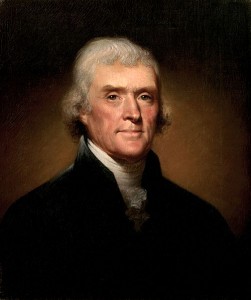Jefferson

By Steve Lowe
This article first appeared in the WASHLine, the Washington Area Secular Humanist’s January 2012 newsletter. Reprinted with permission.
Living in the Washington area provides numerous opportunities not available to most Americans because the Smithsonian Institution is in our backyard. One such occasion is visited upon us until May 28th, 2012. The so-called Jefferson Bible has been placed back on display in a new, expanded exhibit at the Smithsonian’s American History Museum on the National Mall. Having deteriorated in the 191 years since its creation in 1820 by Jefferson and his book binder in Richmond, it was taken into the museum’s conservation laboratory where it was gingerly deconstructed, examined forensically, digitally photographed, repaired and reconstructed into its original leather binding. It can be visited again in a gallery dedicated to it on the Museum’s second floor.
Essentially, Jefferson took the four books of Matthew, Mark, Luke, and John, in which each—differently—tell the story of one man, and merged them into one chronological story only 82 pages long. Of the 3,779 verses in all four books, he extracted only 1,089, or 29%! In a letter to his friend William Short he said of this: “I separate, therefore, the gold from the dross.” He left out redundancies, miracles, and parts he considered unbelievable, unreliable, or unnecessary to appreciate the moral teachings of Jesus, which Jefferson considered to be: “… the most sublime and benevolent code of morals which has ever been offered to man.”
Having selected the verses, which he listed in a Table of Contents, he went about constructing a book–like a scrapbook–by literally cutting out his selected verses from the Bible and pasting them onto blank pages of paper. If you have ever cut out coupons from a newspaper or magazine, you quickly realize the potential of ruining one coupon by cutting out one on the reverse side of the page. Realizing this in advance, Jefferson acquired two exact copies of the same edition of the Bible from which to cut his verses!
These two English Bibles, with verses cut out, are also on display in the Smithsonian exhibit. To see these scissor-and-knife scarred “holy books” desecrated by Jefferson is a most inspiring experience! Even more impressive, being a man of letters and able to read several languages, he did the same cut-and-paste exercise in four languages: Greek, Latin, French, and English. Thus, when you look at the opened book, there are four columns, two on each page, where one can read the same verses in each language from left to right. So, if he had compiled just the English texts, the book would have been only 20 pages long!
He starts with Luke, chapter 2, leaving out that whole ‘virgin birth’ thing; and ends with Matthew 27:60: “There laid they Jesus, ….and rolled a great stone to the door of the sepulcher, and departed”, thus dropping the ‘raised from the dead and resurrection’ thing. In between, all of the miracles are left, so to speak, on the cutting room floor leaving only what Jefferson titled his work: The Life and Morals of Jesus of Nazareth: Extracted textually from the Gospels in Greek, Latin, French & English.
Jefferson had his pages bound by a printer in Richmond and never intended for it to be published or even known about by others. It was in the possession of his great granddaughter when it was bought by the librarian of the Smithsonian Institution in 1895 for $400. In 1902 the U.S. Congress commissioned 9,000 copies of Jefferson’s book to be printed by the Government Printing Office and made available to all congressmen. When these copies ran out in the 1950s no more were printed for this official distribution. A copy of this Congressional edition is on exhibit along with Jefferson’s single original bound (now restored) book. The contents of his book have been transcribed and available from book publishers for many years and numerous editions of it are available from book sellers. The Smithsonian has created a new life-sized facsimile on quality paper and leather binding using the high quality photographs of each page taken while the book was being examined and conserved in the laboratory. It is available in the Smithsonian bookstore or it can be read on-line at the new website dedicated to this exhibit at http://americanhistory.si.edu/JeffersonBible/.
I highly recommend visiting this exhibit to be inspired by it and to make your telling of this courageous feat of Jefferson even more interesting.
Steve Lowe is a member of the Washington Area Secular Humanists (WASH) and lives in Washington DC.
